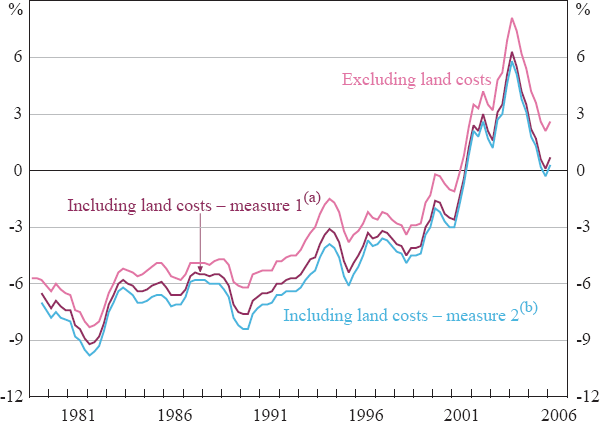RDP 2006-08: A Survey of Housing Equity Withdrawal and Injection in Australia Appendix A: Measurement of Aggregate Housing Equity Withdrawal
August 2006
- Download the Paper 422KB
Conceptually, the amount of equity withdrawn or injected at the macroeconomic level is the difference between the change in the household sector's total debt secured against the housing stock, and net spending by the household sector on dwellings.[18] One approach using readily available data is to calculate the spending component as the sum of investment in dwelling structures (dwelling investment) and ownership transfer costs.[19] While a useful indicator of broad trends, this approach understates the true level of housing equity injection. In particular, the land content (both the cost of undeveloped land and development costs) of a new dwelling typically represents a significant part of the purchase price. If the land is purchased from the business or government sector, then its cost should also be included in calculations of housing equity flows by the household sector.
Figure A1 presents aggregate measures of housing equity withdrawal that make some attempt to capture land purchases by the household sector. The land component is calculated by multiplying an estimate of the average land cost per dwelling by an estimate of the number of dwellings built on land newly acquired from outside the household sector. There are no hard data on the proportion of new dwellings built on land acquired from outside the household sector. One measure in Figure 1 assumes 50 per cent of new dwellings are built on such land (as presented in RBA 2005). An alternative measure can be constructed with a time-varying proportion of dwellings built on new land by making use of information provided by various state planning authorities. This suggests that around 60 per cent of new dwellings are built on such land – down from around 85 per cent in the mid 1980s. In Figure A1, these two measures are compared to the measure of housing equity withdrawal that ignores land costs completely.

Notes:
(a) Assumes the household sector incurs land costs on 50 per cent of new dwellings
(b) Assumes the household sector incurs land costs on a decreasing proportion of new
dwellings
Sources: ABS; APM; Australian Treasury; RBA
Average land costs are calculated as the difference between estimates of the price of a new dwelling (including the land) and the average cost of building a new dwelling (the latter based on new dwelling investment and dwelling completions in each quarter). These data imply that land currently accounts for around 40 per cent of the price of the average new dwelling, and that this ratio has been trending up over time.
If every household in Australia were surveyed, and their net injections and withdrawals were summed together, this measure should, in principle, correspond with the aggregate measures. The net change in debt for all households would match the change in total housing-secured debt. Households that injected equity by purchasing a dwelling would exactly offset all of those that withdrew by selling a dwelling – except for those that purchased a newly built dwelling. In practice, however, a small sample survey like the one undertaken for this paper will suffer from measurement error, including from a limited overlap between surveyed dwellings purchased and sold.